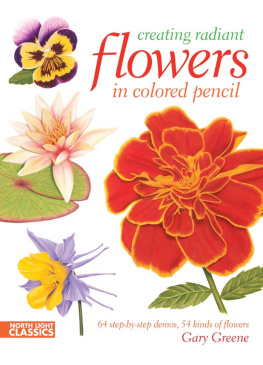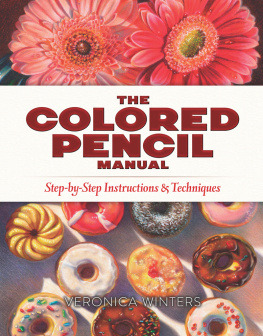creating radiantflowersin colored pencil
GARY GREENE

 DEDICATION To my son, Gregg, a constant source of pride and joy ACKNOWLEDGMENTS Thanks to my wife, Patti, who spent many hours alone by the television and who took on additional responsibilities while I wrote this book. Special thanks to the six contributing artists, Susan Brooks, Edna Henry, Kristy Kutch, Sherry Loomis, Judy McDonald and Terry Sciko, who contributed their time and considerable talent to this project. Thanks again to Rachel Wolf, Pam Seyring, Joyce Dolan, Amy Jeynes, Angela Wilcox, Pam Koenig and everyone at North Light Books, who are first-rate people to work with. ARTISTS STATEMENT Weve all gone shopping for shoes and, after trying on a number of pairs, suddenly know when we have found the right pair. The fit, the look, the statement they make about usthey all come together. In a similar way, this is how colored pencil became my medium of choice as well as the crux of my artistic expressiona melding of personality and purpose.
DEDICATION To my son, Gregg, a constant source of pride and joy ACKNOWLEDGMENTS Thanks to my wife, Patti, who spent many hours alone by the television and who took on additional responsibilities while I wrote this book. Special thanks to the six contributing artists, Susan Brooks, Edna Henry, Kristy Kutch, Sherry Loomis, Judy McDonald and Terry Sciko, who contributed their time and considerable talent to this project. Thanks again to Rachel Wolf, Pam Seyring, Joyce Dolan, Amy Jeynes, Angela Wilcox, Pam Koenig and everyone at North Light Books, who are first-rate people to work with. ARTISTS STATEMENT Weve all gone shopping for shoes and, after trying on a number of pairs, suddenly know when we have found the right pair. The fit, the look, the statement they make about usthey all come together. In a similar way, this is how colored pencil became my medium of choice as well as the crux of my artistic expressiona melding of personality and purpose.
While receiving my fine art education in mainstream mediums, I endured instructors relentless admonishments to work loose, something I was incapable of doing. Fifteen years into my parallel careers of technical illustration, graphics and photography, I was still searching for a medium that fit my fine art aspirations. Then I found myself in an art store where I innocuously picked up a book, The Colored Pencil by Bet Borgeson. It was an epiphany. Colored pencil was love at first stroke! At last I had found a medium that satisfied my obsessions to create paintings with a photographic look. Twenty-eight years ago, creating serious art in colored pencil was indeed different.
Most people thought it was something children used to scribble in coloring books, not a fine art medium. Because colored pencil paintings require a great deal of time to produce (I may spend over 500 hours on a single painting), working from live subjects or en plein air is impractical, if not impossible, so I work exclusively from photographs that I compose specifically for art subjects. If the subjects I paint are man-made, I employ my tools of the trade from my days as a technical illustrator (great fodder for art snobs)straightedges, templates and curvesto create precise shapes and sharp edges. After convincing people that my paintings are, indeed, executed entirely with colored pencil, I frequently hear the comment, Gee, you must have a lot of patience! to which I facetiously reply, If youre in front of me in the left lane on the freeway and going the speed limit, youll soon find out how much patience I have. If my artwork required patience, I could not possibly have done it on an almost daily basis for twenty-eight years and still have retained my amaranthine interest. Gary Greene
WHAT YOU NEED FOR THIS BOOK
SURFACE Strathmore 3-ply bristol vellum used for most demonstrations in this book.
For exceptions, see individual demonstrations. COLORED PENCILS See individual demonstrations for colors and brands TOOLS Pencil sharpener (electric sharpener recommended) Erasers: kneaded, imbibed, electric Erasing shield Pencil lengtheners Bestine (rubber cement thinner) Turpenoid (odorless turpentine) Containers for solvents and water Brushes: nos. 2, 4, 6 and 8 round watercolor Dry applicators for solvent: cotton swabs (recommended); cotton balls, rags, cheesecloth can also be used. 2B and 7H graphite pencils Desk brush Fine sandpaper (emery boards) Drafting or tracing paper Craft knife with #11 blade 
foreward
There is a giddy obsessiveness in Gary Greenes colored pencil renditions. Photo-realistic? No, that would be a rather shoddy compliment. His interpretations have more to do with the interplay of tension and relaxation than with copied flatness.
Garys work is fascinating. Seeing several of his paintings at a time is mesmerizing. At first glance, our eyes widen, then squint. Foolishly, we try to make sense of the bouncing three-dimensional shapes crashing through what we still believe is a flat drawing surface. But when we let ourselves go, the sensation becomes eerily that of Alice falling into the rabbit holeexhilarating and scary at the same time. Compelled to stare, we experience a gradual increase of tactile tingling.
Between our fingers we actually feel the delicate thinness of a rose petal; our noses twitch at the heady aroma of garden-fresh bell peppers. And, with a shiver, we scrape our fingernails across the grating texture of ship metal lying at anchor. Gradually, our eyes bob with the abstract waves of blue and purple, gold and redand we suddenly begin to know Gary. He loves color and form and texture and what they do to the senses, both his and ours. The more we look at his work, the more were sure he loves to giggle, laugh and tease. But as quickly as we get a sense of the artist, his work draws us back to the sensual art of looking.
Good art always does that. Gary has the ability to make us discover and fall in love with the greatness in the simplest of objects. His interplay of similar, competing and repetitive textures is an attention grabber. But then, just as quickly, the tension relaxes as we actually hear the lapping of wavelets beneath a sailboard or feel the various thicknesses of multicolored paint layers peeling from an old set of oars or smile at the smell of gray metal once covered with slick, glossy car enamel. Garys images not only defy the surface, they take us to another world. This new flower book is simply another set of sights and sounds and smells for us to enjoy and learn from.
Its impossible to be neutral about Gary Greenes workand just as impossible to be neutral about Gary Greene.
Bernard A. Poulin
AUTHOR, The Complete Colored Pencil Book
introduction
When my first book,
Creating Textures in Colored Pencil, was half complete, I approached North Light Books with the idea of writing
Creating Radiant Flowers in Colored Pencil. My proposal was met with mild enthusiasm until I explained the popularity of flowers as art subjects. Floral paintings constitute approximately one-third of all images I receive from members of the Colored Pencil Society of America (CPSA) for publication in our newsletter. The percentage is the same for entries in the CPSA International Exhibition and the
Best of Colored Pencil book series (Rockport).
With all this interest, why were there no books on painting flowers with colored pencil? I discovered colored pencil twenty-eight years ago, when there was only one book on the subject: Bet Borgesons landmark The Colored Pencil. Today there are dozens, as many artists are abandoning their watercolors, oils, acrylics and pastels and discovering the creative possibilities of colored pencil. Youre now reading the revised edition of the first book on how to paint flowersalways a favorite subjectwith colored pencil, the hot new art medium! Creating Radiant Flowers in Colored Pencil depicts a variety of flowers in a simple straightforward way without the visual distractions of backgrounds and containers or the verbal distractions of artspeak. Its not intended to be a book on botanical illustrations, nor is it a paint by numbers book. For example, you may want to paint a still life with a certain kind of flower, such as a zinnia. This book will show you how to paint a zinnia, along with sixty-three other flowers.





 DEDICATION To my son, Gregg, a constant source of pride and joy ACKNOWLEDGMENTS Thanks to my wife, Patti, who spent many hours alone by the television and who took on additional responsibilities while I wrote this book. Special thanks to the six contributing artists, Susan Brooks, Edna Henry, Kristy Kutch, Sherry Loomis, Judy McDonald and Terry Sciko, who contributed their time and considerable talent to this project. Thanks again to Rachel Wolf, Pam Seyring, Joyce Dolan, Amy Jeynes, Angela Wilcox, Pam Koenig and everyone at North Light Books, who are first-rate people to work with. ARTISTS STATEMENT Weve all gone shopping for shoes and, after trying on a number of pairs, suddenly know when we have found the right pair. The fit, the look, the statement they make about usthey all come together. In a similar way, this is how colored pencil became my medium of choice as well as the crux of my artistic expressiona melding of personality and purpose.
DEDICATION To my son, Gregg, a constant source of pride and joy ACKNOWLEDGMENTS Thanks to my wife, Patti, who spent many hours alone by the television and who took on additional responsibilities while I wrote this book. Special thanks to the six contributing artists, Susan Brooks, Edna Henry, Kristy Kutch, Sherry Loomis, Judy McDonald and Terry Sciko, who contributed their time and considerable talent to this project. Thanks again to Rachel Wolf, Pam Seyring, Joyce Dolan, Amy Jeynes, Angela Wilcox, Pam Koenig and everyone at North Light Books, who are first-rate people to work with. ARTISTS STATEMENT Weve all gone shopping for shoes and, after trying on a number of pairs, suddenly know when we have found the right pair. The fit, the look, the statement they make about usthey all come together. In a similar way, this is how colored pencil became my medium of choice as well as the crux of my artistic expressiona melding of personality and purpose.